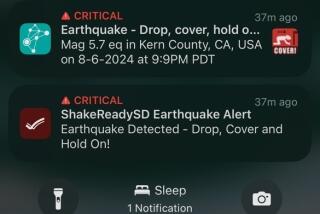Nationwide Effort to Find Missing Children Proposed
WASHINGTON — Since they were first launched in Texas six years ago, “Amber alerts” have been used in more than 15 states and 32 locations to try to rescue missing children.
Named for Amber Hagerman, a 9-year-old kidnapped and brutally murdered in Arlington, Texas, in 1996, Amber--which also stands for America’s Missing: Broadcast Emergency Response--notifies the public through electronic road signs and TV and radio broadcasts that a child is missing.
On Tuesday, pointing to the program as a nationwide model, a bipartisan group of senators, including Democrat Dianne Feinstein of California and Republican Kay Bailey Hutchison of Texas, introduced legislation that calls for the Justice Department to coordinate such alerts across the country. The measure also would provide an estimated $25 million in matching funds for states and localities that do not yet have the training--or the electronic signs--to make the program work.
Advocates say the program has saved lives. The National Center for Missing & Exploited Children estimates that 30 children have been rescued because of Amber alerts. In recent months, during what some have dubbed the summer of child abductions, one of the most high-profile cases was that of Tamara Brooks, 16, and Jacqueline Marris, 17, who were kidnapped at gunpoint from a “lovers’ lane” area in the Antelope Valley. The teens were then raped by Roy D. Ratliff, 37, an ex-convict who was killed during a shootout with sheriff’s deputies.
The case--which led to television appearances and a People magazine cover for the two girls--increased national awareness of Amber alerts.
But some worry that overuse could kill the system’s effectiveness. Like the pictures of missing children on milk cartons, they say, too many alerts, issued indiscriminately, could dull public attention.
“Over-activation will kill the plan,” said Tarrant County, Texas, Sheriff Dee Anderson, who serves on a board of law enforcement and media officials that decides to activate alerts in the Dallas-Fort Worth area. “It should only be used where the child’s life is in danger.”
Already, alerts have been withdrawn by authorities in some cases. An alert was mistakenly issued after the disappearance of a 12-year-old girl in the Bay Area who turned out to be with relatives in Massachusetts. And Nicholas Farber, 9, kidnapped from his father’s home, was found three days later at a San Diego-area campground, where his mother, Debra Rose, involved in a bitter custody battle over the boy, was arrested.
Feinstein noted that of the 13 alerts that have been issued by the California Highway Patrol in the first month of the program in the state, eight involved abductions by strangers, four by family members, and one case was a false alarm.
“But the bottom line is that in all 13 cases, Amber alerts have resulted in the child being returned to his or her family,” she said. “This is powerful evidence. We know it works, and we know that it is a program that should be nationwide.”
Anderson also praised the effectiveness of Amber alerts. “The power of it is amazing when you see it work,” he said. “It’s tremendous, the number of eyes and ears with cell phones.”
But he warned that taking the program nationwide could challenge the delicate relationship between broadcasters--who air news of kidnappings as a public service--and law enforcement.
“There will be pressure on law enforcement to activate the system every time a child is missing, and it takes a thick-skinned administrator to say no,” the sheriff said. “Then the media criticize us for not issuing an alert quick enough.”
As for taking the program national, he questioned the design and intent. “What is national? If a child is missing in New York City, are our radio stations in Texas going to interrupt broadcasting every 15 minutes?” he asked. “There’s a million questions.”
To answer them, the senators are proposing a new Amber alert coordinator in the Department of Justice to coordinate when and how alerts go nationwide, or perhaps regionwide.
Mindful of the concerns about overuse, Hutchison said: “We’re not going to try to interfere with any local alert system. We want it to be simple, expedited. It’s a very modest effort that could save children’s lives.”
More to Read
Sign up for Essential California
The most important California stories and recommendations in your inbox every morning.
You may occasionally receive promotional content from the Los Angeles Times.










